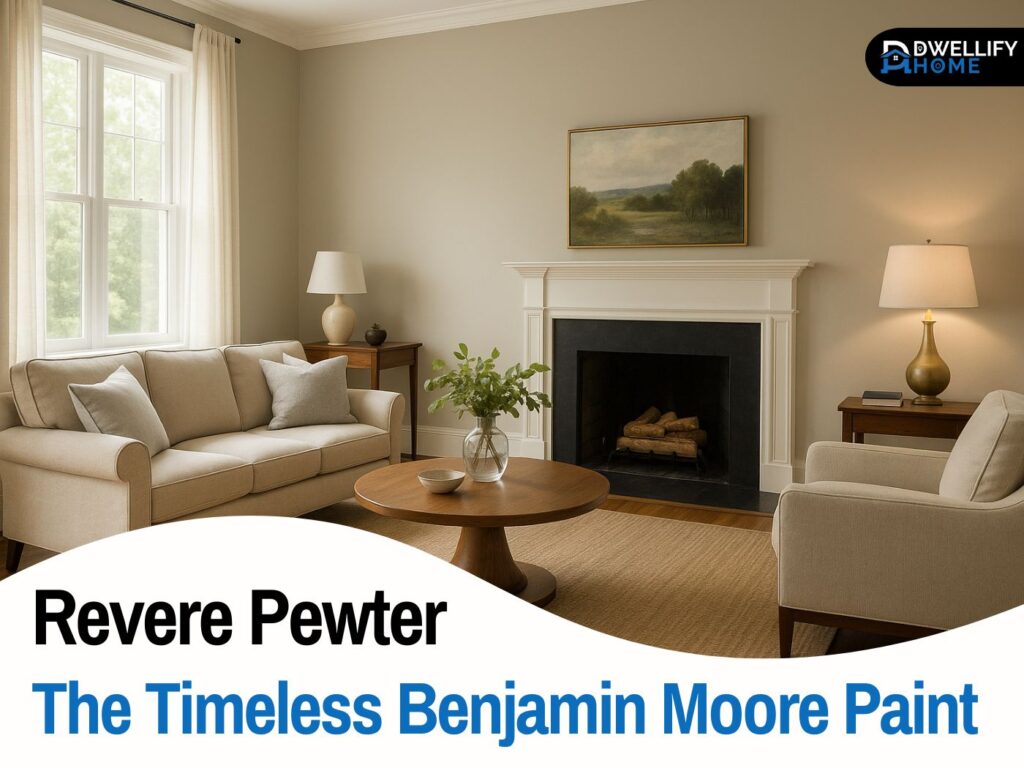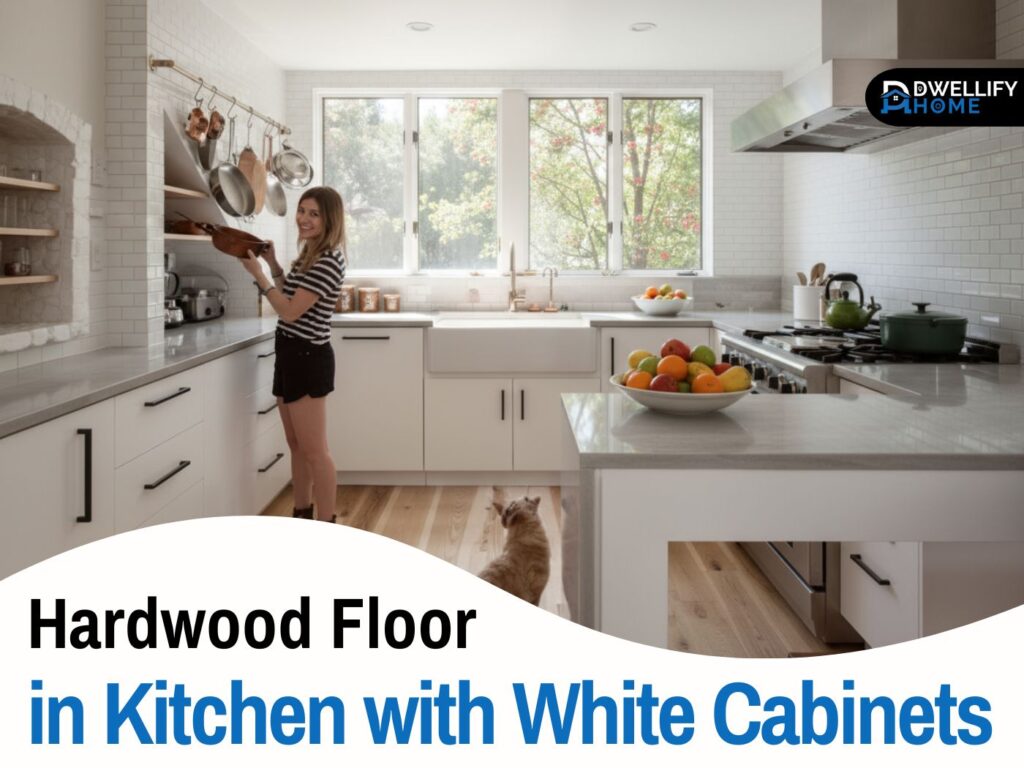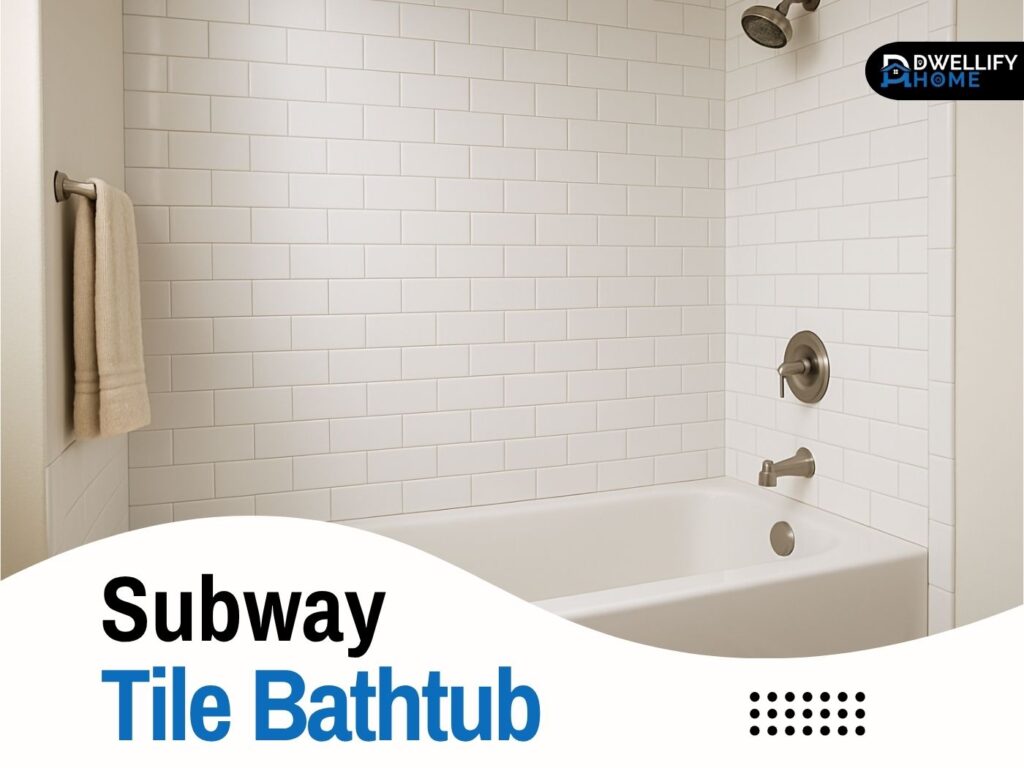If there’s one paint color that seems to never go out of style, it’s Revere Pewter by Benjamin Moore. You’ve probably seen it in Pinterest kitchens, cozy living rooms, or even modern farmhouses on Instagram. Here’s the thing — this shade isn’t just “another gray.” It’s that perfect mix of gray and beige that feels soft, balanced, and welcoming.
As a designer, I’ve used Revere Pewter (HC-172) in so many homes that I’ve lost count. Every time, it somehow fits — whether it’s a beach cottage, an urban apartment, or a suburban family home. In this guide, we’ll go through everything you need to know: undertones, pairings, best uses, comparisons, and expert tips to make it look flawless in your own space.
Snippet-Ready Definition:
Revere Pewter is a warm, balanced “greige” paint color by Benjamin Moore (HC-172). It blends gray and beige tones, creating a timeless, cozy look that complements both modern and traditional homes.
Mission Statement:
At Dwellify Home, our mission is to help readers design beautiful, timeless homes with confidence. We combine expert insights, honest advice, and real-life design experience to make every color choice — from Revere Pewter to bolder hues — simple, smart, and stylish.
What Is Revere Pewter (Benjamin Moore HC-172)?
Let’s start with the basics. Revere Pewter by Benjamin Moore — also known as BM Revere Pewter — belongs to the brand’s Historical Collection (that’s what the HC-172 means). It’s been around for years and remains one of Benjamin Moore’s top sellers because it hits that sweet spot between gray and beige — or as designers love to call it, greige.
The color has an LRV (Light Reflectance Value) of about 55, which means it reflects a medium amount of light — not too bright, not too dark. Its RGB code sits at around (204, 196, 184), and its HEX is #CCC4B8 — all that to say it’s a true mid-tone neutral.
What makes it special is its ability to shift gracefully depending on lighting. It’s cozy in dim light, crisp in daylight, and versatile enough for almost any palette. Whether you call it Benjamin Moore Revere Pewter or Ben Moore Revere Pewter HC-172, it’s one of those colors that just works.
Understanding the Undertones and Lighting Effects
Now, here’s where people get tripped up — undertones. Revere Pewter isn’t a flat gray. It has a soft green-gray undertone that makes it warm and earthy, especially when paired with whites or natural materials.
But lighting can totally change the mood. In a north-facing room, it can lean cooler and a bit grayer. In a south-facing room, it warms up beautifully and feels inviting. If your room gets little natural light, it might look slightly muddy — not bad, just more muted.
Here’s a quick tip: always test paint samples on multiple walls and check them at different times of the day. Morning light and afternoon light can make the same paint look like two different colors.
Why Revere Pewter Stands Out
Designers often call Revere Pewter the “chameleon of neutrals.” And they’re right. It’s that rare color that plays nice with both warm and cool tones.
You can use it with crisp whites for a classic modern look or pair it with beige, cream, and wood for a cozy farmhouse vibe. Its subtle warmth gives rooms personality without overwhelming the space.
The best part is — it never feels trendy. Some grays go cold or blue over time, but Revere Pewter’s greige base keeps it timeless.
How to Use Revere Pewter in Your Home
Let’s talk real-life applications. Whether you’re painting an entire home or just freshening up one room, here’s how Revere Pewter shines in different areas.
1. Interior Walls
If you want your space to feel calm, neutral, and welcoming, Revere Pewter is a winner. I love using it in:
- Living rooms — adds warmth without heaviness.
- Bedrooms — feels serene and pairs beautifully with linen and wood tones.
- Hallways — helps transition between rooms smoothly.
It works especially well in open-concept homes because it doesn’t fight with other colors.
2. Kitchens and Cabinets
Here’s a secret: Revere Pewter kitchen cabinets are absolutely stunning. If you’re tired of white but don’t want dark colors, this is your middle ground. It gives your kitchen a soft sophistication that blends with marble countertops, brass hardware, and white tile.
You can even use it for lower cabinets while keeping the uppers white — a two-tone kitchen that feels designer-approved without the drama.
3. Trim, Doors, and Ceilings
For trims and doors, pair Revere Pewter with White Dove, Chantilly Lace, or Simply White by Benjamin Moore. These create a crisp, clean contrast. If you prefer a softer look, choose a creamy off-white — it blends seamlessly for a cozier feel.
4. Exteriors
Thinking about the outside of your home? Revere Pewter exterior walls look incredible against stone, white trim, or black windows. It’s perfect for siding, brick, or stucco because it adapts to sunlight throughout the day.
Pair it with Kendall Charcoal shutters or a dark front door for serious curb appeal.
Revere Pewter Color Combinations and Coordinating Colors
When it comes to pairing, Revere Pewter color combinations are nearly endless. It sits right in the middle of warm and cool, which gives you freedom to explore.
Here are some tried-and-true combos:
- Classic neutrals: Edgecomb Gray, Balboa Mist, or Classic Gray.
- Accent colors: Navy blue, forest green, soft charcoal, or blush pink.
- Whites: White Dove and Simply White always work beautifully.
- Warm tones: Cream, tan, caramel, or warm wood floors.
You can also create a Revere Pewter color palette that mixes whites, browns, and natural materials for a serene, grounded look.
Revere Pewter vs Other Popular Colors
This is where things get interesting — comparing Revere Pewter vs Accessible Beige or Revere Pewter vs Agreeable Gray is a hot topic in design forums. Let’s clear the air.
Revere Pewter vs Accessible Beige (Sherwin-Williams)
Both are warm neutrals, but Accessible Beige leans slightly more beige and feels warmer overall. Revere Pewter, meanwhile, has that cool undertone that makes it look modern and versatile.
If your room gets lots of sunlight, either works. But in dim light, Revere Pewter’s gray undertone can keep it from feeling too yellow.
Revere Pewter vs Agreeable Gray (Sherwin-Williams)
These two are often mistaken for twins. But Agreeable Gray is a bit lighter and more consistent — it stays gray even in warm light. Revere Pewter, on the other hand, adds a hint of warmth and depth, which gives your space more character.
Think of it like this:
- Want something crisp and modern? Choose Agreeable Gray.
- Want cozy, flexible, and classic? Go with Revere Pewter.
Other Comparisons
- Repose Gray – cooler, less earthy.
- Balboa Mist – lighter, creamier version.
- Edgecomb Gray – a softer cousin, ideal for small spaces.
Best Décor Pairings and Styles
Here’s the fun part — styling!
Revere Pewter looks beautiful with almost every interior style. Whether your home is rustic, modern, or coastal, it finds a way to fit right in.
Pair it with:
- Natural wood furniture for a warm, organic feel.
- Black accents for modern contrast.
- Brass and gold fixtures to bring out its beige side.
- Soft blues or greens to play off its undertones.
In open floor plans, it’s ideal because it balances different zones without clashing.
Expert Tips & Best Practices
After years of working with this color, here are my top insider tips:
- Always sample before painting. Use peel-and-stick sheets or sample pots on different walls.
- Observe throughout the day. Morning light can make it look cool, while evening light makes it cozy.
- Avoid over-lightening. Diluting it too much can shift undertones into weird territory.
- Mind your sheen. Use eggshell for walls, satin or semi-gloss for cabinets.
- Match with your floors. Works best with warm hardwood, natural oak, or neutral tiles.
Trust me, if you follow these, you’ll avoid the most common Revere Pewter “uh-oh” moments.
Pros and Cons of Revere Pewter
Like every color, it’s not perfect — but it’s close.
Pros:
- Timeless and classic.
- Works with any décor style.
- Makes small spaces feel bigger and cozier.
- Perfect resale color — buyers love it.
Cons:
- Can look dull in rooms with no natural light.
- Green undertone might clash with pink or red décor.
- Needs careful pairing with trim to shine.
Revere Pewter in 2025 Design Trends
So, is Revere Pewter still popular in 2025?
Absolutely. Even with new colors trending each year, this shade remains a go-to neutral for designers who love subtle sophistication.
What’s changed is how we use it. Instead of painting every wall, designers now use it as an anchor color — pairing it with warmer whites, black accents, and natural materials. It’s part of the “warm minimalism” trend, where comfort and simplicity meet.
So yes — Revere Pewter is still timeless. It’s just evolving with us.
Real-World Examples & Inspiration
One of my clients, for example, used Benjamin Moore Revere Pewter throughout their open-concept home. In the mornings, the light made it look pale gray; by evening, it felt warm and cozy. Their kitchen cabinets in Revere Pewter with white quartz counters turned out gorgeous — elegant yet practical.
On the exterior, another client paired it with black shutters and white trim — the result was a classy, balanced curb appeal that aged beautifully.
That’s the magic of this color: it adapts to your lifestyle and your light.
Maintenance & Longevity
Paint durability matters — and Revere Pewter performs well over time. It doesn’t yellow, fade quickly, or feel outdated. For upkeep, just clean walls gently with a damp cloth. On cabinets, use mild soap and water to keep the finish fresh.
When you need touch-ups, it blends easily — another reason designers love it.
Cost, Availability, and Matching Options
You can find Benjamin Moore Revere Pewter paint at almost any Benjamin Moore store or authorized retailer. A gallon usually costs around $60–$80, depending on the finish.
If you don’t have a Benjamin Moore nearby, you can ask Sherwin-Williams or Behr for a color match. It won’t be exact, but close enough for smaller projects.
Mistakes to Avoid
- Skipping samples. Always test before committing.
- Wrong lighting. It behaves differently in warm vs cool light.
- Pairing with clashing tones. Avoid pairing it with overly cool blues or reds.
- Painting every wall. Break it up with white trim or accent walls for dimension.
Conclusion
At the end of the day, Revere Pewter HC-172 is one of those rare paint colors that’s both safe and stunning. It’s warm without being yellow, cool without being cold, and neutral without being boring.
If you’re looking for a shade that makes your home feel balanced, cozy, and timeless — this is it.
Here’s the best part: Revere Pewter always feels right. Whether it’s your first home, a rental makeover, or your forever house, this color quietly supports everything around it — letting your décor, lighting, and personality take the spotlight.
Common Questions (FAQs)
Is Revere Pewter more gray or beige?
It’s both! Revere Pewter is a perfect “greige” — a blend of gray and beige that shifts tone depending on light, offering balance and warmth.
When not to use Revere Pewter?
Avoid it in dark rooms or spaces with pink or red décor, since its subtle green undertones can clash or look muddy.
What colors complement Revere Pewter?
White Dove, Simply White, Hale Navy, Balboa Mist, and soft greens like Saybrook Sage pair beautifully with Revere Pewter.
Is Revere Pewter still popular in 2025?
Yes! It remains a timeless favorite among designers for its versatility and natural warmth — perfect for modern and farmhouse styles alike.
What style of home suits Revere Pewter best?
It suits almost any style — traditional, coastal, modern, or transitional. Its neutrality makes it easy to layer with other tones and textures.
What color is replacing Agreeable Gray?
Warmer neutrals and soft greige tones like Revere Pewter and Accessible Beige are trending as designers move away from cool grays.
Disclaimer
The information provided in this article is for educational and design inspiration purposes only. Actual paint shades may vary based on lighting and surface. Always test colors in your own space or consult a certified designer before final decisions. We are not affiliated with Benjamin Moore or any paint brand.

I’m Bilal, the founder of Dwellify Home. With 6 years of practical experience in home remodeling, interior design, and décor consulting, I help people transform their spaces with simple, effective, and affordable ideas. I specialize in offering real-world tips, step-by-step guides, and product recommendations that make home improvement easier and more enjoyable. My mission is to empower homeowners and renters to create functional, beautiful spaces—one thoughtful update at a time.




